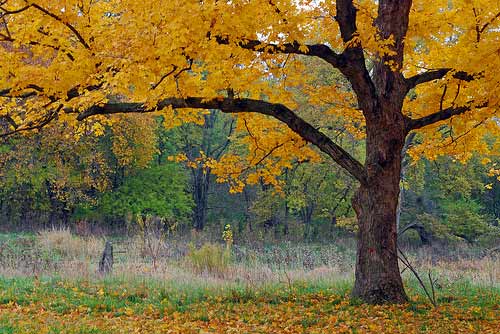By Lisa Swann

The majestic sugar maple’s fall color finery is now at an end — but forest owners are looking forward to the next season: maple sugaring. The syrup you are devouring on your pancakes this holiday season is likely from the last sap run that happened in the spring.
The sugar maple is an amazing tree, from ample summer shade to brilliant fall colors to its ability to produce maple sugar sap, which is boiled down into syrup. Sugar maple (Acer saccharum) is common throughout New England, the Lake States, Mid-Atlantic states, and several Canadian provinces (note the sugar maple leaf on the Canadian flag).
Sugar maples can grow to heights in excess of 100 feet. The national champion sugar maple in New London, Conn., is 124 feet tall, with a diameter of 219 inches and a crown spread of 86 feet. Most trees range in height from 70 to 90 feet and have diameters from two to three feet, and crowns from 60-80 feet. Most sugar maples regenerate naturally through seeds falling to the ground and wide sprouting. They are very prolific seed producers.
A sugar maple stand managed for the production of maple sugar is often referred to as a sugar bush. One of the most important characteristics for a maple sugar tree is a large crown open to sunlight and large stems, which mean high sap rates. In the early 1600s, European explorers witnessed American Indians drawing maple sap, and today maple sugaring is an important cash crop in the New England states.
The tree is also important as a hardwood timber species and was used by settlers to create common kitchen tools such as cheese pressers, rolling pins and apple grinders. Today, it is also popular for flooring, furniture, cabinets and woodenware, as well as basketball courts and baseball bats.
In late summer and fall, sugar maples stop growing and begin storing starches in the sapwood. These starches remain in “storage” until the temperature reaches 40 degrees. When the temperatures warm in the spring, cells holding the starches change them into sugars and the sugar passes into sap. The warmer temperatures create pressure inside the tree and sap begins to flow. It takes 40 liters of maple sap — and hours of boiling down — to make one liter of maple syrup.
So when you enjoy maple syrup this winter, think about the sugar maple tree and the sweet season that is coming.